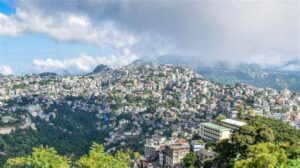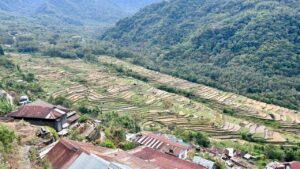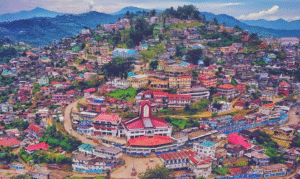In the heart of Meghalaya’s East Khasi Hills lies Mawlynnong, a village that stands out not just for its beauty but for its way of life. Known as “God’s Own Garden,” this village earned the title of the “Cleanest Village in Asia” in 2003, given by Discover India. Yet, this accolade is merely the surface of its charm. Beyond its spotless streets and flower-lined pathways lies a story of resilience and unity, where every resident contributes to a shared vision of sustainable living.
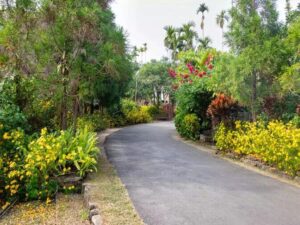
Cleanliness: A Way of Life
The first thing you notice in Mawlynnong is its spotless streets. Flowers bloom along neat pathways, and there isn’t a single piece of trash in sight. This cleanliness isn’t for show—it’s part of everyday life.
Every morning, villagers- young and old, come together to clean their streets and homes. For them, it’s more than a task; it’s about respecting the land they live on. Bamboo dustbins are placed around the village, and everyone carefully separates their waste. Biodegradable items are turned into compost, while non-biodegradable items are collected and disposed of responsibly.
Plastic bags have long been banned in Mawlynnong, and every home has a working toilet. These simple yet effective practices keep the village clean and healthy, showing how small actions can make a big difference.
The Khasi Tribe: Living Close to Nature
The people of Mawlynnong belong to the Khasi tribe, known for their rich traditions and strong connection to the earth. One of the unique things about the Khasi is their matrilineal system, where family names and property are passed down through women. This practice empowers women and strengthens the community.
The Khasi people also take care of their environment through sustainable farming. They grow crops like rice, betel nuts, and fruits naturally, without using harmful chemicals. For them, protecting the land isn’t just a practice—it’s a way of life handed down from their ancestors.
Things to See and Do in Mawlynnong
Mawlynnong is not just about clean streets. It’s also a place filled with natural wonders and cultural treasures.
Living Root Bridges:
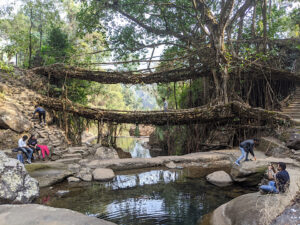
Just outside the village, you’ll find the incredible Living Root Bridges. These natural bridges are made by guiding the roots of rubber trees over streams and rivers. Strong and sturdy, they take years to grow and symbolize the deep bond between the Khasi people and nature.
Sky View Tower: For stunning views, climb the Sky View Tower. Built from bamboo, this tower lets you see the rolling hills and valleys all the way to Bangladesh on a clear day. Standing at the top, surrounded by greenery, you can truly appreciate the beauty of the region.

Waterfalls: Close to Mawlynnong, the sound of rushing water leads you to serene waterfalls like Nohwet Falls. These spots are perfect for relaxing and taking in the peaceful atmosphere of the area.
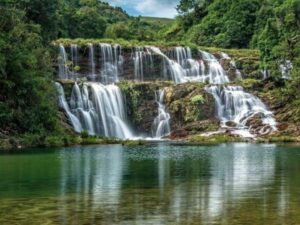
Church of Epiphany
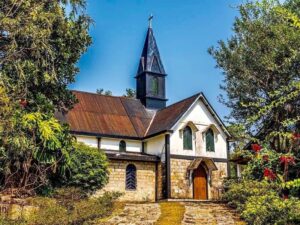
The century-old Church of Epiphany stands as a quiet reminder of the village’s diverse heritage. Its mix of European and local styles makes it a lovely place to visit, whether you’re seeking a moment of peace or simply admiring its beauty.
A Taste of Mawlynnong: Local Food and Life
Life in Mawlynnong revolves around community and tradition. Agriculture is their main work, but eco-tourism also plays a growing role in supporting the villagers.
Food here is fresh, simple, and delicious, made with ingredients straight from the fields and gardens. Don’t miss the chance to try local dishes like jadoh (a flavorful rice and meat dish), pukhlein (sweet rice cakes), and dohneiiong (pork cooked with black sesame seeds). Homestays often serve these dishes, giving visitors a chance to experience the warm hospitality of Khasi families.
Balancing Tourism and Tradition
As Mawlynnong’s popularity grows, so do the challenges of managing the influx of visitors. On busy days, the village welcomes up to 250 tourists, making it essential to preserve its unique way of life while accommodating curious travelers. To address this, the community has implemented thoughtful measures to protect their culture and environment.
Visitors are required to pay a small entry fee, which helps fund the village’s maintenance efforts. Additionally, vehicles are parked outside the village to minimize pollution and maintain its pristine charm. The locals actively engage with visitors, sharing stories of their heritage, traditions, and sustainable practices, fostering a sense of mutual respect and understanding.
Among the many travelers drawn to Mawlynnong’s charm were Ashneer Grover, the co-founder of BharatPe, and his wife, Madhuri Jain Grover. Captivated by the beauty of the region, Madhuri shared glimpses of their visit on social media, describing Mawlynnong and its surroundings as “known for its waterfalls, living root bridges, garden of caves, cleanest villages, tropical rainforests. Lots to see!” Their visit highlights the village’s growing reputation as a must-visit destination, attracting not only nature lovers but also some of India’s most well-known personalities.
Through careful planning and the dedication of its people, Mawlynnong has managed to balance the benefits of tourism with the preservation of its traditions and environment, ensuring that its charm remains intact for future generations.

Mawlynnong’s Message to the World
Mawlynnong is not just Asia’s cleanest village; it’s a shining example of how communities can live harmoniously with nature while preserving their cultural heritage. The village’s commitment to sustainability, community-driven efforts, and cultural pride set it apart as a model for the rest of the world.
A visit to Mawlynnong is more than just a trip to a picturesque village; it’s a journey into a way of life that teaches us the importance of responsibility, respect, and sustainability. As you walk its clean streets, marvel at the Living Root Bridges, and savor its local food, you’ll leave not only with memories, but with a renewed sense of connection to the earth and its people.


